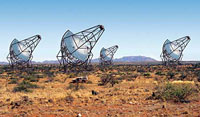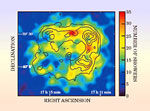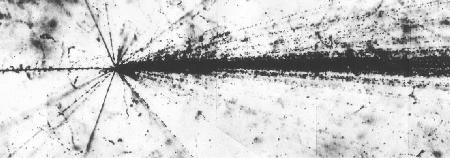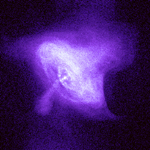Recent evidence from Gamma Rays
Added December 2004
As noted under Supernovas above, cosmic rays are scattered from their original directions by magnetic fields in space. The magnetic force is weak, but acting over distances on the interstellar scale, it thoroughly mixes the directions of cosmic ray particles and makes them arrive evenly from all directions.
Presumably, however, cosmic ray ions start from matter denser than the interstellar medium, and may collide with it on their way out. Nuclear collisions produce gamma rays (after some intermediate steps) which, like light, move in straight lines, If only we could detect ultra-energetic gamma rays from the sky, we might pin-point sources of cosmic rays.
At long last, gamma rays of energies of the order of 800 Gev have been detected and tracked. (For comparison, the rest energy E = mc2 of a proton is a little below 1 GeV). Such gamma rays interact strongly with the atmosphere, to produce pairs of very fast electrons and positrons (positive counterparts of electrons), which quickly produce gamma rays, each of which again produces a pair of lower energy, each of which... and so on, ending with an "air shower" of thousands of electrons, positrons and gamma rays, all still moving at close to the original direction.
In a vacuum, no particle can move faster than light. The atmosphere however slows down light by a slight amount (related to the refraction of light by air), and therefore in air electrons can outrun light, if they are fast enough. When that happens, they emit a sort of "shock front" of light, like the sonic shock ahead of a wing moving at supersonic speed. This light is known, after its Russian discoverer, as "Cherenkov light" (Ch as in Church); if you have seen the glow coming from a nuclear research reactor operating inside a pool of water--that is one example.
Flashes of Cherenkov light from air showers have been studied for many years. They clearly indicate the presence of high-energy gamma rays, but for a long time there was no way of telling if those rays originated in distant space or (more likely) in nuclear collisions of cosmic ray ions in our own atmosphere. Recent studies, however, have not just detected flashes, they also used giant telescopes to focus the light and observe an image of its sources. It turns out, gamma rays from distant space give a different signature, and are readily distinguished.

Several such telescopes exist, and more are being added. As early as in 1989, a gamma ray shower was observed to come from the Crab Nebula, the remnant of a recent supernova explosion; this was accomplished by the Whipple telescope at Kitt Peak, Arizona. Now an array of 4 giant mirror-telescopes has joined the search, each measuring 13 meters across (for the scale, note small truck in front of the nearest telescope); the optical quality is not even close to that of astronomical telescopes, and the ability to resolve a location in the sky is only like that of the unaided human eye. The huge size is however needed to capture a sufficient intensity of the weak Cherenkov light emission. (Science, vol 305, p. 1392-3, 3 September 2004; also Physics Today, vol 58, p. 19-21, January 2005)
This is the HESS telescope array--its name standing for High Energy Spectroscopic System, and also honoring Victor Hess, who discovered cosmic rays in 1912. Rising in a balloon in what is now the Czech Republic (then part of Austria), Hess measured the "background rate" of nuclear radiation, finding it actually increased with height. For that he was awarded the Nobel Prize in 1936.
 Located in Namibia, in southern Africa, HESS quickly discovered in the southern skies a ring-like source of very high-energy gamma rays, about 1 degree across. It is centered at the remnant of supernova RX J1713.7-3946, believed to be about 1000 years old ("High-energy particle acceleration in the shell of a supernova remnant," [a collaboration by about 100 co-authors], Nature, 432, p. 75-7, 4 November 2004). The picture on the right gives the result: colors indicate gamma-ray intensity, while black lines are contours of previously observed X-ray emission from the same supernova remnant. As Paula Chadwick of the University of Durham said, "If you had gamma-ray eyes and were in the southern hemisphere, you could see a large, brightly glowing ring in the sky every night." (Or at least you could, if you were able to collect all the gamma-ray signal of 26 hours into a single bright display, as HESS did.)
Located in Namibia, in southern Africa, HESS quickly discovered in the southern skies a ring-like source of very high-energy gamma rays, about 1 degree across. It is centered at the remnant of supernova RX J1713.7-3946, believed to be about 1000 years old ("High-energy particle acceleration in the shell of a supernova remnant," [a collaboration by about 100 co-authors], Nature, 432, p. 75-7, 4 November 2004). The picture on the right gives the result: colors indicate gamma-ray intensity, while black lines are contours of previously observed X-ray emission from the same supernova remnant. As Paula Chadwick of the University of Durham said, "If you had gamma-ray eyes and were in the southern hemisphere, you could see a large, brightly glowing ring in the sky every night." (Or at least you could, if you were able to collect all the gamma-ray signal of 26 hours into a single bright display, as HESS did.)
Though these results were reported recently, the observations date to the middle of 2003. Another report (Science, 309, p.746, 7-29-2005) tells of a point-source of high energy gamma rays from an X-ray binary, observed by HESS. More data should already be available, and other Cherenkov telescopes are operating, too. We should soon know a lot more about the origins of cosmic radiation!
Added November 2007
The gamma rays observed by HESS have energies of the order of 1012 electron volts, presumably produced by cosmic ray particles of even higher energies,while almost all cosmic ray particles have much less. However, the distribution of cosmic ray energies extends even further (in very small numbers, true), and some have energies more than a million times larger. Such particles are very, very rare, but they have been detected, by the huge showers of secondary particles produced by their collisions in the atmosphere. Because they are extremely rare, huge arrays of detectors need to be distributed over large areas, in the hope of occasionally detecting the arrival of such particles. The most successful array so far has been the Pierre Auger Observatory, covering 3000 square kilometers in Argentina.
Unlike the high energy particles detected by HESS, such cosmic rays were believed to come from outside our galaxy, because galactic magnetic fields are too weak to trap them. Scientists also wondered, what sources could create such huge energies. As reported in the article "Correlation of Highest Eneregy Cosmic Rays with Nearby Extragalactic Objects" ("Science" 318, p.938-943, summary p. 896, issue of 9 November 2007, a collaboration of 300 co-authors), such sources have now been identified--they are indeed outside our galaxy, and unusual. They seem to be active galactic nuclei, probably involving huge black holes.
Cosmic Rays and the Magnetosphere
Where does the magnetosphere enter all this? Neither acceleration by
collision-free shocks nor other particle acceleration processes observed or
proposed in space can be duplicated in the laboratory. We have no way of
reproducing the large distances and low densities of space, and the
phenomena cannot be scaled down properly to laboratory dimensions.
In trying to understand the physics of such phenomena, the Earth's space
environment is our best laboratory, and satellites are the probes which can
provide us with relevant information. For instance, the Earth's bow shock
(a relatively mild shock wave) can be studied for varying solar wind speeds and
magnetic field angles, and some acceleration processes indeed seem to occur
there.
Shock acceleration can also take place inside the magnetosphere (click here for the story of one such event, in March 1991).
Yet other acceleration modes exist too, in substorms and auroral beams, and
similar processes may also occur in the distant universe and on the Sun. In the
long run, the most important reason for studying
the magnetosphere might well be that here is our own "cosmic laboratory," replicating the processes which affect the distant universe.
Questions from Users:
***




 Located in Namibia, in southern Africa, HESS quickly discovered in the southern skies a ring-like source of very high-energy gamma rays, about 1 degree across. It is centered at the remnant of supernova RX J1713.7-3946, believed to be about 1000 years old ("High-energy particle acceleration in the shell of a supernova remnant," [a collaboration by about 100 co-authors], Nature, 432, p. 75-7, 4 November 2004). The picture on the right gives the result: colors indicate gamma-ray intensity, while black lines are contours of previously observed X-ray emission from the same supernova remnant. As Paula Chadwick of the University of Durham said, "If you had gamma-ray eyes and were in the southern hemisphere, you could see a large, brightly glowing ring in the sky every night." (Or at least you could, if you were able to collect all the gamma-ray signal of 26 hours into a single bright display, as HESS did.)
Located in Namibia, in southern Africa, HESS quickly discovered in the southern skies a ring-like source of very high-energy gamma rays, about 1 degree across. It is centered at the remnant of supernova RX J1713.7-3946, believed to be about 1000 years old ("High-energy particle acceleration in the shell of a supernova remnant," [a collaboration by about 100 co-authors], Nature, 432, p. 75-7, 4 November 2004). The picture on the right gives the result: colors indicate gamma-ray intensity, while black lines are contours of previously observed X-ray emission from the same supernova remnant. As Paula Chadwick of the University of Durham said, "If you had gamma-ray eyes and were in the southern hemisphere, you could see a large, brightly glowing ring in the sky every night." (Or at least you could, if you were able to collect all the gamma-ray signal of 26 hours into a single bright display, as HESS did.)